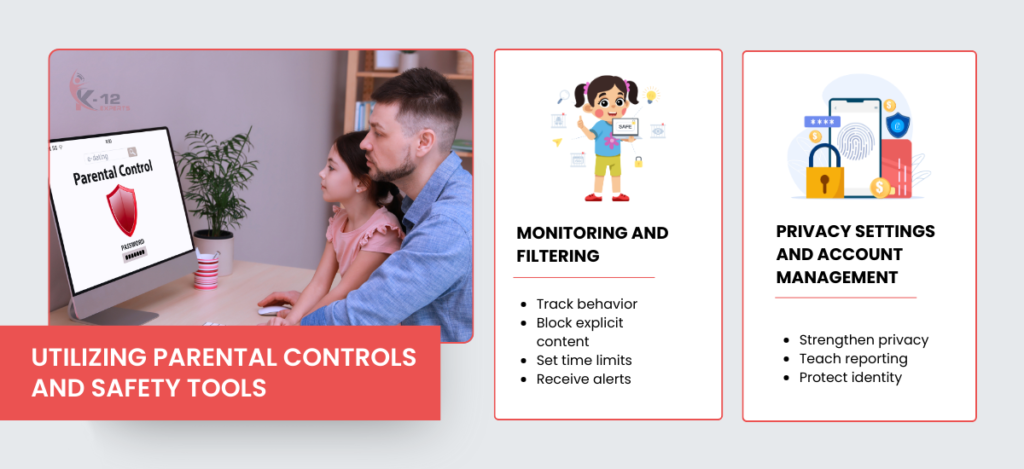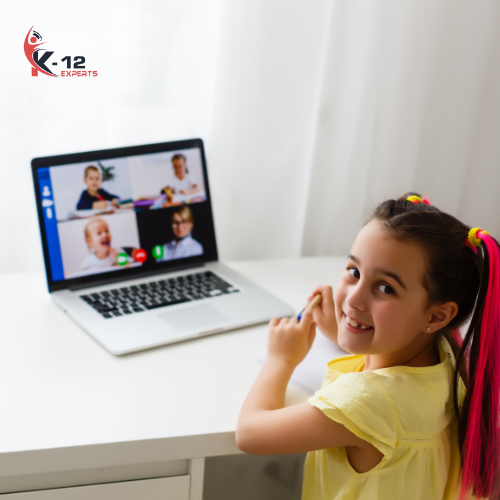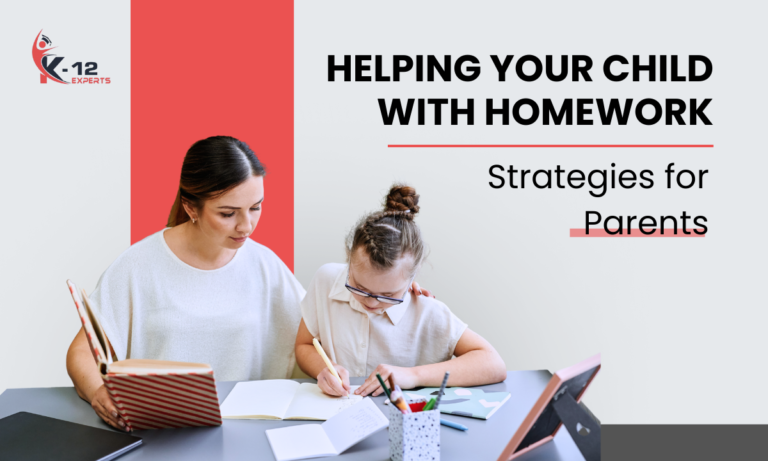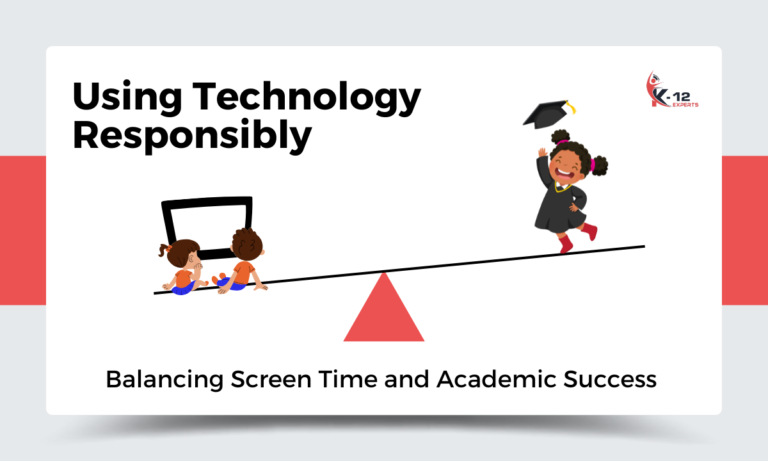As you hand your child their first smartphone, a mix of emotions surfaces – excitement for the endless learning opportunities, yet dread of the potential dangers lurking online.
You want to shield them from the risks of cyberbullying, mature content, and online predators, but you also want to give them the freedom to explore and learn.
You’re not alone in this concern. By taking proactive steps to create a safe online environment, you can empower your child to navigate the digital world confidently.
But where do you start, and what are the most effective strategies to guarantee their online safety?
Key Takeaways
- Set clear boundaries and rules to promote responsible online behavior and prevent risks to your child’s online safety.
- Utilize parental controls and safety tools to monitor online activities, filter explicit content, and protect your child’s online identity.
- Foster open communication with your child to empower them to navigate online risks and build trust in your guidance.
- Encourage critical evaluation of online content and teach your child to identify and report suspicious or harmful activities.
- Model positive online behavior and demonstrate responsible digital habits to influence your child’s online interactions and promote healthy digital literacy.
Navigating the Online Risks and Dangers

As you navigate the digital landscape with your child, you’ll encounter a range of online risks and dangers that can compromise their safety and well-being.
You need to be aware of these threats, which include cyberbullying, online predators, and exposure to explicit content, in order to take effective steps to mitigate them.
- Cyberbullying and Harassment
Numerous children and adolescents fall victim to cyberbullying and harassment every year, highlighting the need for increased awareness and proactive measures to mitigate this pervasive online threat.
You must be aware of the warning signs, including decreased self-esteem, anxiety, and depression.
Take swift action to address incidents by reporting to authorities and providing emotional support to your child.
- Inappropriate Content and Exposure
The internet provides access to a vast array of content, including material that may be unsuitable for children. You must take steps to prevent access to such material.
| Risk | Consequence | Prevention |
| Exposure to mature themes | Emotional distress | Use parental controls |
| Access to explicit content | Desensitization | Monitor online activities |
| Unsuitable role models | Behavioral problems | Engage in open conversations |
| Unsupervised browsing | Unintended exposure | Implement filtering tools |
- Privacy Risks and Data Security
Frequently, children and adolescents engage in online activities without fully understanding the risks to their privacy and data security.
You must educate your child about online safety and take steps to protect their online identity.
Here are some key concerns:
Identity theft: Your child’s personal info can be stolen and used for malicious purposes.
Data breaches: Their sensitive data can be accessed without consent.
Online tracking: Their online activities can be monitored and recorded.
Permanent digital footprint: Their online actions can have lasting consequences.
- Online Predators and Grooming
As you address the risks to your child’s online privacy and data security, it’s equally important to recognize the threat posed by online predators.
They use social media, online gaming, and other platforms to target and groom victims.
You must monitor online activities, educate your child about online safety, and be aware of emotional and behavioral changes to prevent grooming.
Creating a Safe Online Haven
As you work to create a safe online haven for children, you’ll need to foster open communication and digital literacy, enabling them to understand and navigate online risks and opportunities.
You’ll also need to set clear boundaries and expectations for their online behavior, establishing rules that promote healthy online interactions and minimize potential harm.
Open Communication and Digital Literacy
Establishing trust through open communication is essential in creating a safe online haven for children. By engaging in ongoing conversations with your child about online safety, you’ll empower them to navigate the digital world responsibly.
Discuss topics like cyberbullying, online predators, and digital responsibility to foster a culture of awareness and caution.
4 Reasons Why Open Communication Matters:

- Protects against online threats: Your child will know how to identify and avoid potential dangers.
- Fosters digital responsibility: Encourages your child to think critically about their online actions.
- Builds trust: Strengthens your relationship with your child, ensuring they’ll come to you with concerns.
- Empowers independence: Equips your child with the skills and confidence to make informed online decisions.
Setting Clear Boundaries and Expectations
How do you guarantee your child’s online experience is both enjoyable and secure? You set clear boundaries and expectations.

Establishing rules and guidelines for online behavior is vital in creating a safe online haven. You need to define screen time limits, content restrictions, and online etiquette expectations. By doing so, you help your child understand what’s and isn’t acceptable online behavior, promoting responsible online behavior and preventing online risks.
Clear boundaries and expectations also give your child the freedom to explore the online world without the risks associated with unrestricted access. You’re proactive in protecting your child from online threats and empower them to make informed decisions about their online interactions.
This way, your child can enjoy the benefits of the internet while staying safe.
Utilizing Parental Controls and Safety Tools

You can create a safe online haven for your children by utilizing parental controls and safety tools that monitor and filter their online activities.
To do this effectively, you’ll need to manage privacy settings and set up accounts that restrict access to inappropriate content.
Monitoring and Filtering
While the internet offers a wealth of educational and entertaining resources for children, its lack of regulation and anonymity also pose significant risks to their safety and well-being.
You can mitigate these risks by monitoring and filtering their online activities.
- You can see what they’re doing: Track their online behavior and identify potential threats.
- Block access to explicit content: Restrict access to specific websites or types of content.
- Set time limits: Establish boundaries on their online activities.
- Be alert to suspicious activity: Receive notifications when unusual behavior is detected.
Privacy Settings and Account Management
Effectively managing online accounts and utilizing robust privacy settings are essential steps in creating a safe online environment for children.
You should guarantee your child’s online accounts have strong passwords and strict privacy settings.
Educate your child on reporting online abuse, managing profiles, and protecting their online identity.
This enables them to navigate the internet safely and responsibly.
Empowering Your Child Online
You play an essential role in empowering your child online by promoting responsible online behavior and building a supportive online community.
By doing so, you’ll equip your child with the skills and knowledge needed to navigate the digital world safely and responsibly.
As you empower your child, you’ll also need to prepare them to handle online conflicts and cyberbullying, which can have a significant impact on their online experience.
Promoting Responsible Online Behavior
As children increasingly engage with digital technologies, promoting responsible online behavior becomes a critical aspect of their online safety and well-being.
To promote responsible online behavior, consider the following key actions:
- Set clear expectations: Establish rules and consequences for online behavior to help your child understand what’s expected of them.
- Model positive behavior: Demonstrate responsible online behavior yourself, as children often learn by observing their parents.
- Encourage critical thinking: Teach your child to critically evaluate online content and sources, considering potential biases and misinformation.
- Foster empathy and kindness: Encourage your child to treat others with kindness and respect online, just as they’d in person.
Building a Supportive Online Community

Frequently, children’s online interactions are limited to people they already know, such as friends and family members; however, building a supportive online community can expand their social circle and expose them to diverse perspectives and experiences.
By facilitating online connections between your child and others who share similar interests and values, you can create a positive digital environment that fosters collaboration, creativity, and social interaction.
Online forums, social media groups, and online clubs can provide opportunities for children to connect with others who share their passions and interests.
Handling Online Conflicts and Cyberbullying
Online conflicts and cyberbullying can escalate quickly, highlighting the need for parents to be vigilant. Learn channels medication with your child enrage them like incidents.
Teach your child strategies for managing online conflict, such as ignoring hurtful comments and seeking support from friends or family members.
Here are four ways to empower your child online:
- Block or report perpetrators: Teach your child how to use ‘block’ or ‘report’ functions on social media platforms and online communities.
- Seek support: Encourage your child to talk to friends, family members, or a trusted adult about online conflicts or bullying.
- Keep records: Document incidents, including dates, times, and details of what happened.
- Escalate if necessary: Involve law enforcement or online authorities if online conflicts or bullying become severe.
Frequently Asked Questions
What Is the Recommended Age for Children to Start Using the Internet?
You’re steering through a vast digital ocean, and the anchor of age guidelines can help you chart a safe course. Experts recommend introducing children to the internet around 6-7 years old when they can grasp online safety basics.
How Can I Monitor My Child’s Online Activity Without Invading Their Privacy?
You can monitor your child’s online activity by setting up parental controls, tracking browsing history, and using monitoring software, but establish open communication to balance safety with respecting their autonomy and individual freedom.
Can I Restrict My Child’s Access to Certain Websites and Apps?
When it comes to kids and the internet, ‘an ounce of prevention is worth a pound of cure.’ You can restrict access to certain websites and apps by setting up parental controls on their devices and networks.
What Should I Do if My Child Is a Victim of Cyberbullying?
If your child’s a victim of cyberbullying, you’ll want to act fast. Document incidents, report them to the platform or school, and offer emotional support; don’t hesitate to involve law enforcement if threats are made.
How Can I Protect My Child’s Personal Data From Online Predators?
As a guardian of your child’s digital footprint, you’re the firewall that shields their personal data from online predators; to fortify this defense, use strong passwords, enable two-factor authentication, and monitor their online activities closely.




